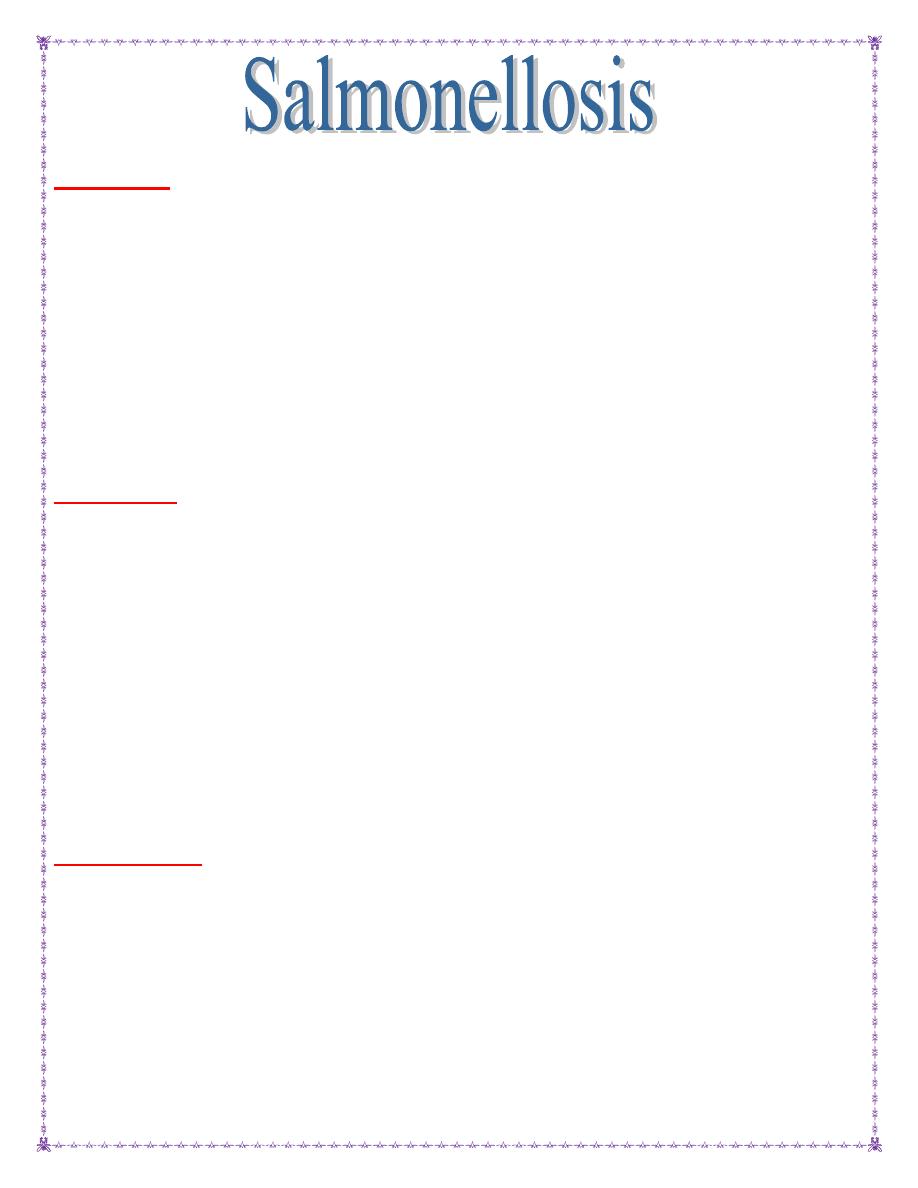
1
|
P a g e
Definition
It is a gram-negative motile bacilli.
It belongs to the family Enterobacteriaceae.
Classification of Salmonellae species were defined by different combinations of somatic O,
surface Vi, and flagellar H antigens.
Bacteria of the genus Salmonella are highly adapted for growth in both humans and
animals and cause a wide spectrum of disease. The growth of serotypes S.Typhi& S.
Paratyphi is restricted to human hosts, in whom these organisms cause enteric (typhoid)
fever. The remaining serotypes (nontyphoidal salmonella) can colonize the GIT of a broad
range of animals, including mammals, birds, and insects. More than 200 serotypes are
pathogenic to humans, in whom they often cause gastroenteritis and can be associated
with localized infections and/or bacteremia.
Enteric Fever
Epidemiology
In contrast to other Salmonella serotypes, the etiologic agents of enteric fever, S.
Typhi&S. Paratyphi serotypes A, B, and C—have no known hosts other than humans.
Most commonly, food-borne or waterborne transmission results from fecal contamination
by ill or asymptomatic chronic carriers. Sexual transmission between male partners has
been described. Health care workers occasionally acquire enteric fever after exposure to
infected patients or during processing of clinical specimens and cultures.
it is estimated to occur in about 6,000 people per year in the United States
In 2013 it resulted in about 161,000 deaths
The risk of death may be as high as 25% without treatment while with treatment it is
between one and four percent
Pathophysiology
Typhoid and paratyphoid fevers, which are transmitted by the faeco-oral route, are
caused by infection with Salmonella typhi and S. paratyphi A and B. After a few days of
bacteraemia, the bacilli localize, mainly in the lymphoid tissue of the small intestine(distal
ilium), resulting in typical lesions in the Peyer's patches and follicles. These swell at first,
then ulcerate and usually heal. After clinical recovery, about 5% of patients become
chronic carriers; the bacilli may live in the gallbladder for months or years and pass
intermittently in the stool and less commonly in the urine.

2
|
P a g e
Clinical features
I.P. 7-14 days
1st week:
Fever (stepladder fashion for 4 or 5 days). The fever pattern is stepwise, characterized by
a rising temperature over the course of each day that drops by the subsequent morning.
The peaks and troughs rise progressively over time.
Headache.
Myalgia.
Relative bradycardia.
Constipation.
Diarrhoea and vomiting in children.
(epistaxis) is seen in a quarter of cases.
2nd week:
Rose spots on trunk (rash on the upper abdomen and on the back as sparse, slightly
raised, rose-red spots, which fade on pressure. It is usually visible only on white skin in
35%).
The major symptom of this fever is that the fever usually rises in the afternoon up to the
first and second week then platue up to 40c
Splenomegaly.
Cough.and basal ronchi
Abdominal distension & tenderness.
Diarrhoea. +vewidaltest(anti O and H)
3rd week:
Delirium, complications, then coma and death (if untreated).
Intestinal haemorrhage due to bleeding in congested Peyer's patches this can be very
serious, but is usually not fatal.
Intestinal perforation in the distal ileum: this is a very serious complication and is
frequently fatal
The fever is still very high and oscillates very little over 24 hours
By the end of third week, the fever starts subsiding (defervescence). This carries on into
the fourth and final week.

3
|
P a g e
Paratyphoid fever
The course tends to be shorter and milder than that of typhoid fever.
The onset is often more abrupt with acute enteritis.
The rash may be more abundant
The intestinal complications less frequent.
Complications
Intestinal perforation and hemorrhage.
Extra-intestinal complications: include
-Endocarditis.
-Vascular infections.
-Cholecystitis.
-Hepatic and splenic abscesses
-Nephritis.
-Pneumonia or empyema.
-Meningitis.
-Septic arthritis, and osteomyelitis ( in sickle cell anemia).
-Reactive arthritis.
Investigations
Blood culture (especially in the first week).80%
Bone marrow culture is superior to blood culture, since the bacterial concentration is 10
times that of blood (even if patient received antibiotics).90%
Stool & Urine culture in the third week.30-40%
WBC count, may be normal, leukopenia, neutropenia In 15–25% of cases, Leukocytosis is
more common among children, during the first 10 days of illness, and in cases complicated
by intestinal perforation or secondary infection.
eosinopenia and relative lymphocytosis
The Widal test is negative in the first week and +ve in 2nd week
Treatment
The initial choice of antibiotics depends on the susceptibility of the S. Typhi and S.
Paratyphi strains in the area of residence or travel.
Macrolides and 3rd generation cephalosporin are preferred for empirical therapy.
Ceftriaxone, cefotaxime, and (oral) cefixime are effective for treatment of enteric fever,
These agents clear fever in ~1 week, with failure rates of ~5–10%, fecal carriage rates of
<3%, and relapse rates of 3–6%.
Oral azithromycin results in clearance of fever in 4–6 days, with rates of relapse and
convalescent stool carriage of <3%.

4
|
P a g e
fluoroquinolones are the most effective class of agents, with cure rates of ~98% and
relapse and fecal carriage rates of <2%. Experience is most extensive with ciprofloxacin.
Short-course ofloxacin therapy is similarly successful. However, the increased incidence of
resistant S. Typhi in Asia, which is probably related to the widespread availability of
fluoroquinolones over the counter, is now limiting the use of this drug class for empirical
therapy.
Chloramphenicol (500 mg 6-hourly), ampicillin (750 mg 6-hourly) and co-trimoxazole (2
tablets or i.v. equivalent 12-hourly) are losing their effect due to resistance in many areas
of the world, especially India and South-east Asia.
Ceftriaxon 1 gm x 2 for 6 days
Azethromycine 500 mg x 2 for 6 days
Ceprofloxacin 750 mg x 2 fo 14 days
Steroid therapy has shown to be beneficial in some patients with severe enteric fever and
coma, delirium, or shock. Dexamethasone is administered at doses of 3 mg/kg initially,
followed by 1 mg/kg every 6 hours for 48 hours. Steroids can mask the signs and
symptoms of abdominal perforation and should not be continued for more than 48 hours.
Treatment should be continued for 14 days.
Pyrexia may persist for up to 5 days after the start of specific therapy.
Even with effective chemotherapy there is still a danger of complications, relapse of the
disease and the development of a carrier state.
Treatment of carrier
Salmonella can be treated for 4–6 weeks with an appropriate oral antibiotic. Treatment
with oral amoxicillin, trimethoprim-sulfamethoxazole (TMP-SMX), ciprofloxacin, or
norfloxacin is ~80% effective in eradicating chronic carriage of susceptible organisms.
However, in cases of anatomic abnormality (e.g., biliary stones), eradication often requires
both antibiotic therapy and surgical correction.
Prevention
Improved sanitation and living conditions reduce the incidence of typhoid.
Two typhoid vaccines are commercially available: (1) Ty21a, an oral live attenuated S.
Typhi vaccine (given on days 1, 3, 5, and 7, with a booster every 5 years); and (2) Vi CPS,
a parenteral vaccine consisting of purified Vi polysaccharide from the bacterial capsule
(given in 1 dose, with a booster every 2 years). The minimal age for vaccination is 6 years
for Ty21a and 2 years for Vi CPS. Currently, there is no licensed vaccine for paratyphoid
fever.

5
|
P a g e
Before the advent of antibiotic therapy, typhoid fever had a mortality rate of 20 to 25%.
This rate has been reduced to less than 1% in industrialized countries. However, the
mortality rate remains as high as 30 to 50% in some areas of developing countries..
In the preantibiotic era, 5 to 10% of patients who recovered from typhoid fever had
relapses. Relapses continued to occur in 10 to 15% of patients treated with
chloramphenicol, ampicillin, and trimethoprim-sulfamethoxazole but seemed to be much
less frequent in those treated with ceftriaxone and fluoroquinolones (<5%).
Relapses typically occur approximately 1 week after therapy is discontinued, but relapse
after 70 days has been reported
A relapse of typhoid fever is generally milder and of shorter duration than the initial
illness. In rare cases, second or even third relapses occur
Previous infection does not confer immunity. In any suspected relapse, infection with a
different strain should be ruled out
Untreated survivors of typhoid fever may shed the bacterium in the feces for up to 3
months. Therefore, after disease resolution, 3 stool cultures in one-month intervals should
be performed to rule out a carrier state. Concurrent urinary cultures should be
considered.
